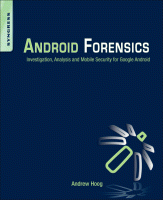Browse content
Table of contents
Actions for selected chapters
- Full text access
- Book chapterAbstract only
Chapter 1 - Android and mobile forensics
Pages 1-40 - Book chapterAbstract only
Chapter 2 - Android hardware platforms
Pages 41-63 - Book chapterAbstract only
Chapter 3 - Android software development kit and android debug bridge
Pages 65-103 - Book chapterAbstract only
Chapter 4 - Android file systems and data structures
Pages 105-157 - Book chapterAbstract only
Chapter 5 - Android device, data, and app security
Pages 159-194 - Book chapterAbstract only
Chapter 6 - Android forensic techniques
Pages 195-284 - Book chapterAbstract only
Chapter 7 - Android application and forensic analysis
Pages 285-364 - Book chapterNo access
Index
Pages 365-372
About the book
Description
Android Forensics: Investigation, Analysis, and Mobile Security for Google Android provides the background, techniques and analysis tools you need to effectively investigate an Android phone. This book offers a thorough review of the Android platform, including the core hardware and software components, file systems and data structures, data security considerations, and forensic acquisition techniques and strategies for the subsequent analysis require d. this book is ideal for the classroom as it teaches readers not only how to forensically acquire Android devices but also how to apply actual forensic techniques to recover data.
The book lays a heavy emphasis on open source tools and step-by-step examples and includes information about Android applications needed for forensic investigations. It is organized into seven chapters that cover the history of the Android platform and its internationalization; the Android Open Source Project (AOSP) and the Android Market; a brief tutorial on Linux and Android forensics; and how to create an Ubuntu-based virtual machine (VM). The book also considers a wide array of Android-supported hardware and device types, the various Android releases, the Android software development kit (SDK), the Davlik VM, key components of Android security, and other fundamental concepts related to Android forensics, such as the Android debug bridge and the USB debugging setting. In addition, it analyzes how data are stored on an Android device and describes strategies and specific utilities that a forensic analyst or security engineer can use to examine an acquired Android device.
Core Android developers and manufacturers, app developers, corporate security officers, and anyone with limited forensic experience will find this book extremely useful. It will also appeal to computer forensic and incident response professionals, including commercial/private sector contractors, consultants, and those in federal government.
Android Forensics: Investigation, Analysis, and Mobile Security for Google Android provides the background, techniques and analysis tools you need to effectively investigate an Android phone. This book offers a thorough review of the Android platform, including the core hardware and software components, file systems and data structures, data security considerations, and forensic acquisition techniques and strategies for the subsequent analysis require d. this book is ideal for the classroom as it teaches readers not only how to forensically acquire Android devices but also how to apply actual forensic techniques to recover data.
The book lays a heavy emphasis on open source tools and step-by-step examples and includes information about Android applications needed for forensic investigations. It is organized into seven chapters that cover the history of the Android platform and its internationalization; the Android Open Source Project (AOSP) and the Android Market; a brief tutorial on Linux and Android forensics; and how to create an Ubuntu-based virtual machine (VM). The book also considers a wide array of Android-supported hardware and device types, the various Android releases, the Android software development kit (SDK), the Davlik VM, key components of Android security, and other fundamental concepts related to Android forensics, such as the Android debug bridge and the USB debugging setting. In addition, it analyzes how data are stored on an Android device and describes strategies and specific utilities that a forensic analyst or security engineer can use to examine an acquired Android device.
Core Android developers and manufacturers, app developers, corporate security officers, and anyone with limited forensic experience will find this book extremely useful. It will also appeal to computer forensic and incident response professionals, including commercial/private sector contractors, consultants, and those in federal government.
Key Features
- Named a 2011 Best Digital Forensics Book by InfoSec Reviews
- Ability to forensically acquire Android devices using the techniques outlined in the book
- Detailed information about Android applications needed for forensics investigations
- Important information about SQLite, a file based structured data storage relevant for both Android and many other platforms.
- Named a 2011 Best Digital Forensics Book by InfoSec Reviews
- Ability to forensically acquire Android devices using the techniques outlined in the book
- Detailed information about Android applications needed for forensics investigations
- Important information about SQLite, a file based structured data storage relevant for both Android and many other platforms.
Details
ISBN
978-1-59749-651-3
Language
English
Published
2011
Copyright
Copyright © 2011 Elsevier Inc. All rights reserved
Imprint
Syngress
